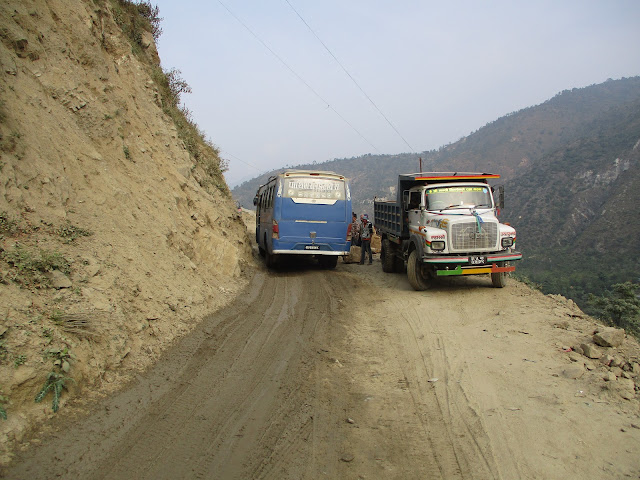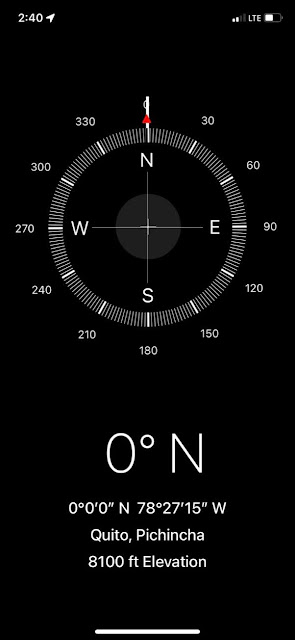Okhaldhunga, Nepal
After a night in Queens, we left JFK early for Kathmandu on Qatar Airlines. As gold card carrying perennial coach class members, we have experienced some really sucky flights from Hawaii over the years, including the last one on Alaska Airlines in the rear seats next to the bathroom with a sick Asian couple coughing on us, oh, say every six or seven minutes.
So the first leg, JFK to Qatar was quite the payback. Brand new plane with wide seats that were surrounded by empty seats and plenty of legroom. Two full Indian style meals, with silverware, snacks and drink service (free quality booze as well, although as we had such a big trip ahead of us we didn't imbibe) every few hours, more entertainment than one could watch and more. We laughed as we compared our Hawaii trips on United Airline's ageing fleet, non reclinable cramped seats in which you could pay to download entertainment on your cell phone and the sodium laden pretzel look a like snacks.
The Qatar to Kathmandu leg however, involved an hours long deboarding due to *equipment failure* and chaotic hours of ever changing planes and gates. The old plane was packed to the gills with young Nepali men returning, probably for the first time in years, from contract labor in places like Qatar and Dubai. Before landing, we had to circle Kathmandu for an extra hour or so due to *overcrowding*, then after landing, wait on the tarmac for another hour also due to *overcrowding*. In all fairness, the Kathmandu airport was heavily damaged in the 2015 earthquake.
We were beginning our journey in Kathmandu, visiting Jamie and her new Nepalese husband, Bijen, shown here at their new farm project in Okhaldhunga, about 135 miles southeast of Kathmandu. Jamie is a long time friend of Lilly's, initially meeting at Kalani in ~2009. She continued to visit Hawaii and these two partners in crime have adventured in Alaska, Thailand, India and other places over the years.
Jamie married Bijen in 2018 and they now split their time between a pied a terre in Kathmandu and their future farm home in Okhaldhunga.
In spite of our flight being around six hours late and close to 11:00 PM, their driver was there to pick us up and deliver us to a discreet hotel in the tony ex-pat/embassy neighborhood of Jhamsikhel. We slept off the jet lag, venturing out only to eat and after three days were ready for the real journey: the village of Maajhi Gaon in the province of Okhaldhunga.
All rested, we headed out of chaotic Kathmandu with Milan, a driver recommended by our hosts and followed the Khurkot-Ghurmi Madhya Padadi Highway that basically follows the Sunkoshi River Valley.
The abridged version of the geological story is: ~250 million years ago, this area was covered by the Tethys Ocean located between the ancient continents of Gondwana and Laurasia. The ocean dropped sediments and the Eurasian and Indian tectonic plates bumped and banged up against each other in on-going continent to continent collision creating the Himalaya Mountain chain.
As the sediments eroded off the mountains, a gigantic alluvial fan of metamorphosed sand, gravel, mudstone, sandstone, shale, boulders and other conglomerates was created. Glaciers and melting glacial water created rivers, such as these in the Khosi river system. They eventually deeply eroded and continue to erode, these mountains of unconsolidated rubble.
Which is a convoluted way of saying this is one hell of a hairy six hour ride.
A little landslide is cleared by the passengers of a bus in front of us. Due to driving on the left side of the road, the view of the ~1000 foot drop-off into the valley below is even more harrowing from the front passenger seat when going downhill. That passing truck's wheels are what, six inches from catastrophe?
Stopped for a lunch of mo-mo dumplings, dal baht and best cafe latte ever on the way.
Made it in one piece to Harkapur, where Bijen and Jamie picked us up at the gas station. We piled in to their car and went to on another hairy road to their village Maajhi Goan.
Okhaldhunga means grinder in Nepali, although more of a mortar and pestle type thing than the rice grinder shown above. Bijen says the villagers now use a more modern one with a foot pedal.
Jamie has been a math teacher for 14 years in New York, Italy and Thailand (there is a picture of her visiting the Field of Dreams at Kalani somewhere on this blog). On the side she liked to volunteer for non-profits. Her vocation and avocation came together when she began teaching at the UNIS (United Nations International School) and started taking students to Nepal. She met Bijen, who has an MBA from the private King's College in Babarmahal and is a free lance all around web and video maestro who is also was interested in NGO's (non-governmental voluntary charity). It was love at first sight and they married in 2018.
Their current NGO mission is to teach the villagers of Maajhi Goan (and beyond) about cash crops and to start a school lunch program for the village kids.
Above Bijen plants potatoes and carrots in what is hopefully the first of many greenhouses.
Bijen does the plumbing on the building that will house volunteers, work trade and WWOOF (World Wide Opportunities on Organic Farms) types. All construction work is done by villagers.
We helped a bit watering and planting mustard and several other unfamiliar greens that were generically referred to as "green leaf".
We stayed with their neighbors across the lane. Top room on right.
Our host Mina cooks some noodles for some school kids one morning. Mina and her husband Vishnu are Brahmin, the highest caste in Nepal.They live in the nicest part of the village. One of their sons who is in college in Kathmandu was there for a few nights.
The whole village appeared to have siesta time in the afternoon and our room was nice and cool, so that was fine with us.

View of the neighbor's front yard.
Rice, corn, potatoes, green beans, onions, chili, bitter melons, cucumbers, tomatoes, green leaf and squash are some of the crops I saw. The is old school agriculture folks, mostly done by hand and with oxen. The soil is glacial till, which is robust but full of all manner of stones. These are gradually gathered over the decades and made into the walls of the terraced gardens.
In a nod to organic farming that never went away, nothing is wasted. For example, the relationship between the goats, chickens, cows and buffalo and the crops. Labor intensive rice is harvest in bunches and left to dry in the fields. When dry, the laborers thrash the rice to remove the seeds, which is taken to a mill to remove the husk to produce white rice. The leftover bunches of rice hay are stacked in trees or on the roofs of rough pens and doled out to the livestock as needed. Their manure is collected, mixed with the brown rice hulls and spread over the fields as fertilized compost.
The days started when a woman brought by fresh milk every morning at 7:30. We pasteurized it for 30 minutes before adding it to our coffee. The farm hopes to start coffee production at a higher elevation soon.
Above, preparing local onions, garlic, taro, chili for afternoon dal baht.
Bijen is an excellent cook and most meals were some variation of Dal Bhat
Cistern used for village water and irrigation for the crops.
One of our showers and place to wash clothes. This mountain spring feeds the cistern.
Wandering around town one day. Although there are organizations like the UN and US AID doing projects around here, white people are rare and a real source of amusement in these villages. Pretty much anywhere we wandered, we were greeted by villagers, school kids and truck drivers alike with curious gapes.
Jamie says the villagers cannot fathom why an American would come here. "They might understand if you were French or something".
The highway is a major trade route between Tibet and India, so there are plenty of travelers from remote mountain towns near the Tibet border that are bewildered by the appearance of what for all intents and purposes might as well be white yetis. Funny for us as well.
So imagine the befuddled crowd that gathered for yuk-em ups when this was going on.
Crossing a bridge over the Sun Khosi river on a supply run to the market town of Ghurmi.
Lilly made a new friend on the second bridge who, despite limited English was quite the Chatty Cathy.
Alas, gentle reader, there is no paradise on this Earth.
Unfortunately, like many *developing* countries, erosion, trash, garbage and water and air pollution like this here are a real sad story, although no where near the unsustainable problem level of places like Kathmandu.
Packing up and ready to roll back to Kathmandu. Our gear is stored on top of Bijen's custom rig and Scabb, their dog, is in the back. Villagers are indifferent to dogs as they don't have the value of a cow or a goat, so they mean nothing to them. They do no harm to dogs but are not going to waste resources on them and certainly are not going to kiss them (fair enough, as after all, they do lick each other's hiney holes).
As such, in these parts, three gringos travelling with a dog in a local rig is a sure way to draw a gawking crowd.
Like we cared.
Safe and sound back at Jamie's and Bejin's 11th story pied a terre. Merry Christmas from all of us in suburban Katmandu!
Thanks for stopping by
































Comments